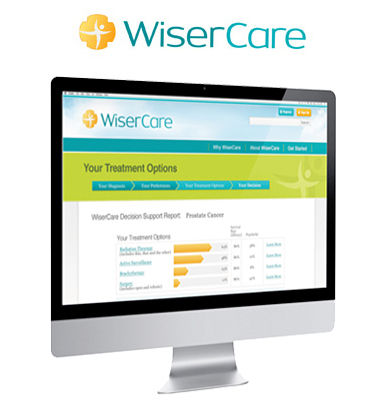This summer interns from Duke University worked on projects with Innovations in Healthcare and SEAD innovators from around the world. In this blog post you will gain insights on Patrick O'Shea's experience working with WiserCare, an interactive, online platform helping patients and doctors make better and informed healthcare decisions.
Imagine yourself in a doctor’s office. You’ve lost about 15 pounds over the past two months, and you’ve had night sweats over that same time. You fear the worst, the big C. The doctor comes in, sits down, and shares the news: cancer. After giving you some time to process this life-altering news, the doctor begins to go through your options. It was challenging to follow the different options with each one’s risks and benefits, so the doctor gives you some reading material and schedules a follow-up appointment next week to set up a treatment course.
These scenarios occur daily in the US healthcare system, the “What do I do?” moments without a clear answer. As a medical student, I have been privy to these conversations from inside the room. Many end up in a very reasonable place, with the patient asking: “If this was your family member, what would you choose?” Many would agree that this is adequate, but it fails to account for the unique attributes of each person.
WiserCare seeks to change that.
WiserCare, based in Seattle, provides an online platform that incorporates shared decision making (SDM) for preference-sensitive medical decisions. In other words, WiserCare helps patients and doctors make better decisions when there is no clear treatment course. Although the concept of SDM has existed for more than 20 years,[1] WiserCare brings SDM into the 21st century through rapid information sharing between patient, provider, and family members (as the patient permits). For known diagnoses, patients can review these modules and complete them in advance of their office visits, ensuring less decisional conflict and uncertainty.[2] For new diagnoses such as the patient above, a WiserCare module allows personalized exploration of physician-reviewed resources on one’s own time. Rather than relying on the doctor’s personal opinions framed through his/her values, WiserCare provides customized resources to identify what you value most regarding the treatment options.
As a future clinician, what excites me most is the potential of WiserCare’s product to impact three areas: overall costs, utilization variation, and patient satisfaction. When implemented, SDM has led to similar outcomes and decreased costs, as patients elect to pursue lower intensity interventions relative to the general population.[3],[4] In a health system where spending as a percentage of GDP dwarfs other industrialized countries,[5] SDM provides a real possibility to reduce a portion of those costs. Utilization variation, often highlighted by the work of the Dartmouth Atlas of Healthcare,[6]was reduced across hospitals in a recent study.[7] Although more research needs to be done in this area, variation reduction can by a proxy for more patient-centered care.[8] Finally, early results from WiserCare have demonstrated greater patient satisfaction scores. This benefits both patients and providers, as CMS continues to incorporate patient satisfaction into reimbursement rates.
WiserCare has real potential to improve the quality of care for patients and providers alike. The question is, are you tapping into that potential?
[1] Charles, Cathy, Amiram Gafni, and Tim Whelan. "Shared decision-making in the medical encounter: what does it mean? (or it takes at least two to tango)." Social science & medicine 44.5 (1997): 681-692.
[2] Stacey D, Bennett CL, Barry MJ, et al. Decision aids for people facing health treatment or screening decisions. Cochrane Database Syst Rev 2011;10:CD001431-CD00143
[3] Arterburn, David, et al. "Introducing decision aids at Group Health was linked to sharply lower hip and knee surgery rates and costs." Health Affairs 31.9 (2012): 2094-2104.
[4] Veroff, David, Amy Marr, and David E. Wennberg. "Enhanced support for shared decision making reduced costs of care for patients with preference-sensitive conditions." Health Affairs 32.2 (2013): 285-293.
[5] D. Squires and C. Anderson, U.S. Health Care from a Global Perspective: Spending, Use of Services, Prices, and Health in 13 Countries, The Commonwealth Fund, October 2015.
[6] http://www.dartmouthatlas.org/
[7] Brabers, Anne EM, et al. "Does a strategy to promote shared decision-making reduce medical practice variation in the choice of either single or double embryo transfer after in vitro fertilisation? A secondary analysis of a randomised controlled trial." BMJ open 6.5 (2016): e010894.
[8] Oshima Lee, Emily, and Ezekiel J. Emanuel. "Shared decision making to improve care and reduce costs." New England Journal of Medicine 368.1 (2013): 6-8.

